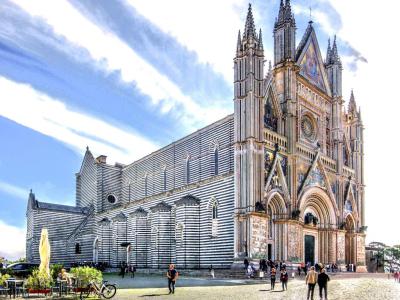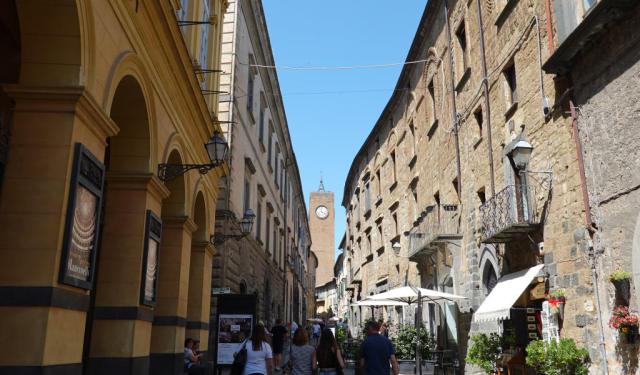Duomo di Orvieto (Orvieto Cathedral), Orvieto (must see)
The Duomo di Orvieto is a true masterpiece of Gothic architecture, renowned for its stunning façade, intricate interior, and rich history.
Construction of the cathedral began in 1290 and continued for centuries, resulting in a remarkable blend of Gothic styles, from Early to Late. The façade, in particular, showcases the transition from the more austere Early Gothic to the elaborate Late Gothic.
The façade of the Duomo di Orvieto is a dazzling display of sculptural artistry. Its ornate marble reliefs and sculptures depict biblical stories, saints, and intricate patterns. The three impressive bronze doors each tell a unique narrative, inviting visitors into a world of spirituality and creativity.
One of the most iconic elements of the façade is the stunning mosaic known as the "Golden Lily" or "Rose Window." This radiant masterpiece features a golden sunburst design with Christ at its center, surrounded by angels, prophets, and apostles. The play of light through this mosaic creates a heavenly ambiance within the cathedral.
Stepping inside, visitors are greeted by a vast and awe-inspiring interior. The nave is adorned with frescoes, many of which were created by renowned Renaissance artist Luca Signorelli. His "Last Judgment" frescoes in the San Brizio Chapel are particularly famous and have inspired countless artists through the ages.
The Orvieto Cathedral is also home to the Chapel of the Corporal, which lies on the north side of the main crossing. It is a place of great religious significance. It houses a precious relic-a corporal cloth with traces of blood from a Eucharistic miracle that occurred in Bolsena in 1263. The chapel's altar and decorations are a testament to the importance of this relic.
The Chapel of Saint Brictius, located in the right transept of the Orvieto cathedral, is renowned for its exceptional frescoes, which adorn the entire interior of the chapel. These frescoes are primarily the work of Luca Signorelli, an influential Italian Renaissance painter. The frescoes depict various scenes from the Last Judgment, the Apocalypse, and the Second Coming of Christ. Signorelli's masterful use of perspective, anatomy, and dramatic composition make these frescoes a true artistic treasure.
Construction of the cathedral began in 1290 and continued for centuries, resulting in a remarkable blend of Gothic styles, from Early to Late. The façade, in particular, showcases the transition from the more austere Early Gothic to the elaborate Late Gothic.
The façade of the Duomo di Orvieto is a dazzling display of sculptural artistry. Its ornate marble reliefs and sculptures depict biblical stories, saints, and intricate patterns. The three impressive bronze doors each tell a unique narrative, inviting visitors into a world of spirituality and creativity.
One of the most iconic elements of the façade is the stunning mosaic known as the "Golden Lily" or "Rose Window." This radiant masterpiece features a golden sunburst design with Christ at its center, surrounded by angels, prophets, and apostles. The play of light through this mosaic creates a heavenly ambiance within the cathedral.
Stepping inside, visitors are greeted by a vast and awe-inspiring interior. The nave is adorned with frescoes, many of which were created by renowned Renaissance artist Luca Signorelli. His "Last Judgment" frescoes in the San Brizio Chapel are particularly famous and have inspired countless artists through the ages.
The Orvieto Cathedral is also home to the Chapel of the Corporal, which lies on the north side of the main crossing. It is a place of great religious significance. It houses a precious relic-a corporal cloth with traces of blood from a Eucharistic miracle that occurred in Bolsena in 1263. The chapel's altar and decorations are a testament to the importance of this relic.
The Chapel of Saint Brictius, located in the right transept of the Orvieto cathedral, is renowned for its exceptional frescoes, which adorn the entire interior of the chapel. These frescoes are primarily the work of Luca Signorelli, an influential Italian Renaissance painter. The frescoes depict various scenes from the Last Judgment, the Apocalypse, and the Second Coming of Christ. Signorelli's masterful use of perspective, anatomy, and dramatic composition make these frescoes a true artistic treasure.
Want to visit this sight? Check out these Self-Guided Walking Tours in Orvieto. Alternatively, you can download the mobile app "GPSmyCity: Walks in 1K+ Cities" from Apple App Store or Google Play Store. The app turns your mobile device to a personal tour guide and it works offline, so no data plan is needed when traveling abroad.
Duomo di Orvieto (Orvieto Cathedral) on Map
Sight Name: Duomo di Orvieto (Orvieto Cathedral)
Sight Location: Orvieto, Italy (See walking tours in Orvieto)
Sight Type: Religious
Guide(s) Containing This Sight:
Sight Location: Orvieto, Italy (See walking tours in Orvieto)
Sight Type: Religious
Guide(s) Containing This Sight:
Walking Tours in Orvieto, Italy
Create Your Own Walk in Orvieto
Creating your own self-guided walk in Orvieto is easy and fun. Choose the city attractions that you want to see and a walk route map will be created just for you. You can even set your hotel as the start point of the walk.
Orvieto Introduction Walking Tour
Some 100 kilometers north of Rome, in the picturesque region of Umbria, lies the old town of Orvieto overlooking the Paglia valley from atop a volcanic plateau. The name "Orvieto" stems from “urbs vetus” which means “ancient town” in Latin. Indeed, Orvieto is old, with its roots traced to Etruscan times, circa the 9th century BC.
Despite having been a major center of Etruscan... view more
Tour Duration: 2 Hour(s)
Travel Distance: 3.4 Km or 2.1 Miles
Despite having been a major center of Etruscan... view more
Tour Duration: 2 Hour(s)
Travel Distance: 3.4 Km or 2.1 Miles




